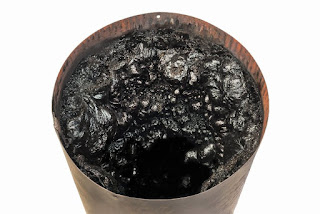In order to prevent the emergence and creasing of creosote on chimney walls, the flue gas temperature must be sufficiently high. It is recommended that during heating the temperature of the chimney at the exit from the furnace is maintained above approx. 130 °C.
Creosote creams are flammable, and besides chimney ignition, it can also reach its tingling, which poses a great risk of poisoning carbon monoxide and other gases resulting from incomplete combustion.
Creosote buildup:
There are already on the market small magnetic thermometers for chimneys which are labeled with insuficient and overheat temperatures:
My version is similar: chimney wall temperautre is measured with IC sensor and displayed with large red 7-segment digits. Thermometer also measures speed of temperature increase/decrease in °C/min. By looking at it you see temperature and how fast chimney is heated (of cooled) which I find very usefull.
My wood stove regulates burn process with air inlets. There are primary air supply doors with butterfly valve for fine air regulation, and secondary air supply shutters on upper and lower side of main glass door.
Chimney wall temperature is measured with IC thermometer which points at narrow area of chimney wall. Used sensor is MLX90614 with some kind of telescopic lens which gives the sensor much lower angle of view compared to default viewing angle:
And from above:
Calculating speed of temperature increase/decrease
As mentioned earlier, this device calculate speed of temperature increase - heating, or decrease - cooling, so by looking at four LEDs on front panel you know wether your stove heats up or cools down, and how fast this heating is. This is done by fitting linear regression line through points of measured temperautre. Angle of linear fit slope is represented with four LEDs, the higher slope is - more LEDs are lit.
Number of measured temperature points, time between measurements and range needed for one LED to lit up can be set with encoder on front panel. My current setup is:
- 8 temperature points (samples),
- 2 seconds between measurements,
- 7 LED lit range.
Based on current setup each LED represents heating/cooling speed of 0,05°C/second.
To use all four LEDs heating is represented by lit from bottom to up, while cooling lits from up to bottom.
Device in operation, stove heats up!
Inside the stove logs of wood are piled up from the large pieces on bottom to the small on top, ensuring that fire progress from top to bottom.
At the first stage of burning all air inlets are fully open, thus ensuring enough oxygen to burning process. After cca 5 mins chimney wall is at 36 °C and heats up by 0,15 °C/s (three LEDs are lit).
After another 2,5 minutes chimney is at 57 °C and heating speed is 0,2 °C/s. All air inlets are still open:
At 127 °C it's time to close primary air door, lefting open only butterfly valve. Secondary air inlets are still fuly open:
After some 15 - 20 min form ignition temperature is 144 °C and it's time to fully close primary air inlet while secondary air shutters are half-closed. Now heating speed drops to 0,05 °C/s and fire intesity is significantly lower (as can be seen through glass):
In this state stove keeps it's temperature almost constant, as confirmed by chimney temperature measurement. Only half way open secondary air is sufficient for maintaining constant temperature:
All in all I find IC thermometer very usefull for monitoring wood stove burning process. It helps fast reaching of optimum burning temperature, which is important for preventing creosote buildup on chimney walls as a result of incomplete combustion.
Thermometers large red numbers and four LEDs for indicating heating speed, makes it clearly visible from distance and all angles. By a quick look at unit it is clear what's going on within stove combustion chamber.













This comment has been removed by a blog administrator.
ReplyDeleteHi Dear,
ReplyDeletei Like Your Blog Very Much..I see Daily Your Blog ,is A Very Useful For me.
https://www.hubert-versand.de/thermobehaelter-thermoboxen/